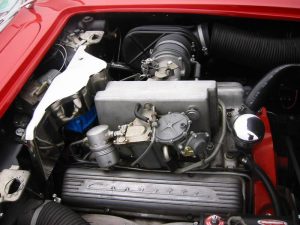Heres’ the latest reader question, along with my reply!
Hank asks: Why does fuel injection need to be electronic? Isn’t it true that mechanically fuel-injected engines were available as long ago as the ’50s? I remember reading about them in high school and then the subject seemed to disappear. Can you shed any light?
My reply: As Ed used to say – you are correct, sir! There were mechanically injected engines back in the ’50s; Chevy, for example, offered this option with the Corvette and the BelAir.
Two reasons: One, it was expensive relative to carburetors and for two, the mechanical injection system could only anticipate how much fuel to inject over a limited spectrum. The system could be set up to work great at wide open throttle – or idle – but the in-between was a problem.
Electronic fuel injection solved it – via maps that encompass practically every conceivable throttle position/load scenario. EFI is much more tunable for street-driven purposes and it need not be overly complex, though it has become so (mainly because of the need to comply with ever-more-intolerant government regs).
In my opinion, the apogee of fuel delivery was reached in the mid-’80s, with Throttle Body Injection (TBI) which combined the simplicity of a carburetor with the superior driveability and low-maintenance of FI.
Port fuel injection upped the complexity, but the system is still overall a plus. But we are now at the point of Direct Injection – which is too complex and expensive for the gains achieved vs. PFI or TBI.
All that said, an early “fuelie” Corvette of Bel Air would be a really neat car to own!
. . .
Got a question about cars, Libertarian politics – or anything else? Click on the “ask Eric” link and send ’em in!
If you like what you’ve found here please consider supporting EPautos.
We depend on you to keep the wheels turning!
Our donate button is here.
If you prefer not to use PayPal, our mailing address is:
EPautos
721 Hummingbird Lane SE
Copper Hill, VA 24079
PS: Get an EPautos magnet or sticker or coaster in return for a $20 or more one-time donation or a $10 or more monthly recurring donation. (Please be sure to tell us you want a magnet or sticker or coaster – and also, provide an address, so we know where to mail the thing!)
If you’d like an ear tag – custom made! – just ask and it will be delivered.
My latest eBook is also available for your favorite price – free! Click here. If that fails, email me at [email protected] and I will send you a copy directly!












The main reason for the GM(Rochester)FI was it is totally unaffected by G forces unlike a carbs floats so no bogging.or flat spots in corners.
Many water cooled VWs and maybe Audi’s had Bosch mechanical port FI, I think it was called K-Jetronic.
Rabbits, Sciroccos, Dashers, and probably 4 and 5000 Audi’s from 77 to about 84?
Most VW models (except the Bug and Bus) had mechanical fuel injection from at least the 60’s through mid 80′;s, as did Vovos. These systems are often portrayed as being finicky and hard to maintain and repair- but I think that that was largely due to the fact that being they were rather rare, most mechanics simply didn’t know how to work on them.
I mean, look at diesels, prior to the late 90’s: They had mechanical injection- just a mechanical injection pump- and thus, they were simple, and extremely durable and efficient…and economical. You could drive all day with a dead battery and a bad alternator…no electricity needed to keep the engine running! Old Mercedes diesel sedans from the 70’s are still a mainstay in places like Africa; and I’d kill for an old mechanically-injected Ford diesel pick-up!
We’ve passed the apex of technology and are now on the downward side. Sure, complexity is increasing- but to the point where it is unnecessary and detrimental, rather than beneficial. The highest technology is that which accomplishes a given task in the simplest way while providing the greatest efficiency and durability- and sadly, we are well past that point
Hi Nunz,
Old VWs like the Squareback and Fastback did have FI, but it was Bosch electronic! I gnoe because I’ve owned ’em both 🙂
Hey Eric!
….leave it to those Krauts! 😀
Eric, that 1960s Bosch fuel injection used by VW was actually an outgrowth of the failed Bendix “Electrojector” electronic injection. (Bendix sold the patents to Bosch where it was further developed into a usable system.)
Although AMC dropped their plans to offer the Electrojector in the ’57 Rebel that fuel injection system did make into a handful of 1958 Chrysler products. Here’s the story of a fuel-injected ’58 DeSoto Adventurer convertible:
https://www.allpar.com/cars/desoto/electrojector.html
Interesting stuff, Jason & Eric.
I have to look into that. I’m thinking that “electronic” as used at the time, was likely similar to “electronic ignition” used in the 70’s on most cars- like the GM HEI or Ford DuraSpark- which just consisted of one simple electronic module with no real feedback, which replaced a purely mechanical component (In the case of electronic igniton, the module simply replacing the points)?
Is that about right, as pertains to those “electronic fuel injection systems”?
Hey, Nunz, judge for yourself. Here’s a description of how the Electrojector electronic fuel worked from the article I linked to. It was more sophisticated than you might think:
“Electronically controlled and electrically actuated, the ‘Electrojector’ had a transistor-equipped brain or modulator, about 5 inches in size. The brain took a timed electrical signal from the ignition distributor. It sensed, through tiny electronic transmitting devices located at key points on the engine, the engine’s temperature, throttle position, manifold pressure and even the altitude (or density) of the air being sucked into the cylinders. The modulator integrated all of the information received and instantly translated this data into a control signal that actuated the injectors, according to an article in Bendixline, a company newsletter, dated Sept. 28, 1956.”
Thanks, Jason!
WoW! Pretty sophisticated for the time! I had no idear!
The Electrojector had many of the attributes of a modern fuel injection system. Considering the electronics technology available in the mid-to-late 1950s though the Bendix engineers over-reached what was really possible at the time.
The photo of the inside of the Electrojector “brain box” looks like what you’d find inside a 1940s radio!
Oops, left off the photo link…
https://www.allpar.com/photos/desoto/electrojector/brain.jpg
Daaaaarn! No wonder nobody knew how to work on ’em!
Hi Nunz,
My ’69 Fastback’s engine had the Bosch PFI system. It had an aluminum “dry” manifold that looked like the TPI set-up GM used in the ’80s. There was a MAF/MAP sensor that got balky sometimes but if you kicked the driver’s side rear quarter panel just right, the car would start.
Not kidding!
My old diesel Cat had no electrical system at all, except for the magneto on the pony motor which started (or not!) with a pull rope.
My cat sounds like a diesel when he purrrs! 😀